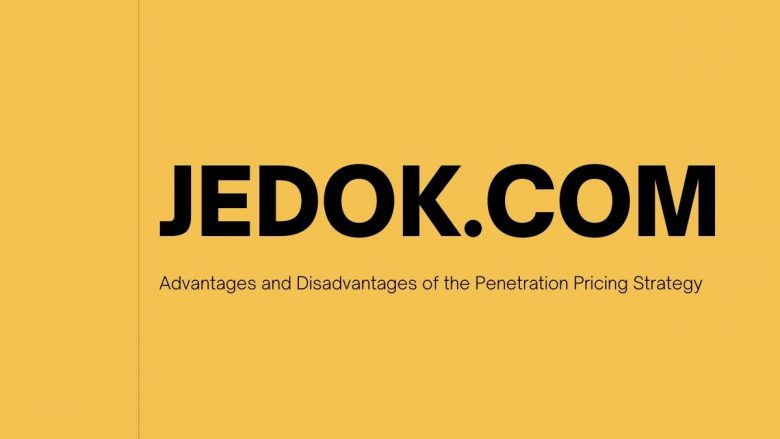
Penetration pricing is a pricing strategy where a company sets a low price for its product or service to enter the market and gain market share. This approach is often used by companies that are introducing a new product or service, or by those that are trying to break into a new market. While this strategy has its advantages, it also has its disadvantages. In this blog post, we will explore the pros and cons of penetration pricing.
Advantages of Penetration Pricing:
1. Attracts customers:
Penetration pricing is a popular pricing strategy used by businesses to gain a foothold in the market. The primary advantage of this approach is that it attracts customers. By setting prices lower than your competitors, you can entice potential customers to try out your product or service. This is especially effective when launching new products since consumers are often hesitant to try something unknown.
Another benefit of penetration pricing is that it can help establish brand loyalty early on. If customers enjoy the experience and quality of your product/service, they are more likely to stick with you even after prices increase. This means that businesses can secure a solid customer base while still maintaining profitability in the long run.
However, it’s important for businesses not to rely solely on low prices as their competitive edge. Customers may view lower prices as an indication of inferior quality or a lack of value-added features/services.
2. Gain market share:
Penetration pricing is a strategy that has been used by many companies to quickly gain market share. This approach is particularly effective for new companies looking to make a name for themselves in their respective industries. By offering lower prices than the competition, businesses can attract customers who are on the lookout for value-driven products and services.
The advantage of penetration pricing is that it allows companies to penetrate the market quickly and establish themselves as viable competitors. Lower prices will help create brand awareness and generate positive word-of-mouth marketing, leading to increased sales volumes over time. The company can then gradually increase its prices once it has established itself as a credible player in the industry.
However, there are also risks associated with this approach. For one, if competitors retaliate by lowering their own prices or increasing their marketing efforts, it can be difficult for a new company to compete effectively.
3. Create a buzz:
Penetration pricing, also known as low price strategy, is a marketing technique where a product or service is introduced into the market with an initial low price. The aim of this strategy is to generate excitement and create a buzz around new products or services. By offering a lower price than competitors, businesses can attract customers who are looking for value and affordability.
This strategy has several advantages that can help businesses gain traction and establish themselves in the market. Firstly, it helps to build customer awareness by creating a buzz around the product or service. Customers are more likely to talk about new products that they feel offer value for their money. This word-of-mouth promotion can be very effective in attracting new customers and building brand loyalty.
Secondly, penetration pricing allows businesses to gain market share quickly by undercutting competitors’ prices. This can help them establish themselves in the market before other players catch up.
4. Discourage competition:
Penetration pricing is a marketing strategy that involves setting low prices for a new product or service to gain market share quickly. One of the biggest advantages of this pricing method is that it can discourage competition from entering the market. Competitors may be hesitant to enter a market where prices are already low, as they may not be able to compete with the established company’s low pricing structure.
Furthermore, competitors who do decide to enter the market will have a more difficult time gaining traction and capturing market share due to the established company’s lower prices. This can give an advantage to the company using penetration pricing by allowing them to establish themselves as the dominant player in the industry and build brand recognition before other companies can gain a foothold.
Overall, while there are many different marketing strategies available, penetration pricing is a proven method for quickly gaining market share and establishing oneself as an industry leader.
Disadvantages of Penetration Pricing:
1. Reduced profit margins:
Reduced profit margins are the primary disadvantage of penetration pricing. This strategy involves setting a low price for a new product or service to attract customers and gain market share. While it can be effective in the short term, the downside is that profit margins are significantly reduced. Companies that use this strategy often have to sell more units to make up for the lower prices.
Penetration pricing can lead to a race to the bottom as competitors may also reduce their prices to remain competitive. This can hurt profitability in the long run, especially if companies cannot maintain market share or increase prices after gaining customer loyalty through low introductory prices.
Furthermore, relying solely on penetration pricing can also harm brand image by creating an expectation among consumers that products or services will always be available at low prices.
2. Risk of price perception:
Penetration pricing is a strategy used by many companies to gain market share by offering products and services at lower prices than their competitors. While this tactic can be effective in attracting new customers, it also carries the risk of creating negative price perceptions among consumers. A low price may create the perception that a product is of lower quality or lacks certain features, leading customers to assume that they are getting what they pay for.
When customers see a lower-priced product, they may automatically assume that it is inferior to higher-priced alternatives without considering other factors such as brand reputation or performance. This perception can be damaging for businesses looking to establish themselves as high-quality providers in their respective industries. In fact, studies have shown that consumers who perceive a product’s quality as being low are less likely to purchase it again in the future.
3. Difficulty in raising prices:
Penetration pricing is an effective strategy that many companies use to gain market share by setting low prices for their products or services. However, once a company has established itself as the price leader in the market, it can be difficult to raise prices without losing customers. In fact, one of the biggest disadvantages of penetration pricing is that it can create customer expectations that are hard to meet in the future.
Customers who have become accustomed to paying low prices may not be willing to pay more for the same product or service. This presents a significant challenge for companies looking to increase margins and profitability. In some cases, companies may need to rethink their entire pricing strategy if they want to maintain their customer base while also increasing revenue.
To mitigate this issue, companies must take a strategic approach when raising prices.
4. Attract price-sensitive customers:
Penetration pricing is a pricing strategy that involves setting a low price for a product when it is first introduced into the market. This strategy can be useful for businesses looking to gain an edge in their industry by attracting price-sensitive customers who are on the lookout for bargains. However, while penetration pricing can be effective in generating sales and increasing market share, it’s not without its drawbacks.
One of the main disadvantages of penetration pricing is that it can lead to lower profit margins. By offering products at a lower price point, businesses may struggle to cover their costs and make a profit. In addition, once customers have become accustomed to purchasing products from a business at such low prices, they may be reluctant to pay more later on if prices are raised.
Another disadvantage of penetration pricing is that it can attract bargain hunters who aren’t loyal customers.
Conclusion
Penetration pricing can be an effective strategy for companies looking to enter a new market or gain market share quickly. However, it is important to weigh the advantages and disadvantages of this strategy before implementing it. Companies should carefully consider their pricing strategy and ensure that it aligns with their overall business goals and objectives.


